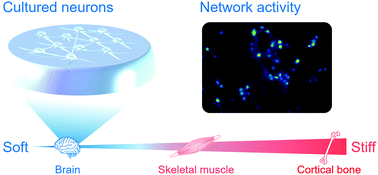当前位置:
X-MOL 学术
›
Soft Matter
›
论文详情
Our official English website, www.x-mol.net, welcomes your feedback! (Note: you will need to create a separate account there.)
Suppression of hypersynchronous network activity in cultured cortical neurons using an ultrasoft silicone scaffold
Soft Matter ( IF 3.4 ) Pub Date : 2020/02/17 , DOI: 10.1039/c9sm02432h Takuma Sumi 1, 2, 3, 4 , Hideaki Yamamoto 1, 2, 3, 4, 5 , Ayumi Hirano-Iwata 1, 2, 3, 4, 5
Soft Matter ( IF 3.4 ) Pub Date : 2020/02/17 , DOI: 10.1039/c9sm02432h Takuma Sumi 1, 2, 3, 4 , Hideaki Yamamoto 1, 2, 3, 4, 5 , Ayumi Hirano-Iwata 1, 2, 3, 4, 5
Affiliation

|
The spontaneous activity pattern of cortical neurons in dissociated culture is characterized by burst firing that is highly synchronized among a wide population of cells. The degree of synchrony, however, is excessively higher than that in cortical tissues. Here, we employed polydimethylsiloxane (PDMS) elastomers to establish a novel system for culturing neurons on a scaffold with an elastic modulus resembling brain tissue, and investigated the effect of the scaffold's elasticity on network activity patterns in cultured rat cortical neurons. Using whole-cell patch clamp to assess the scaffold effect on the development of synaptic connections, we found that the amplitude of excitatory postsynaptic current, as well as the frequency of spontaneous transmissions, was reduced in neuronal networks grown on an ultrasoft PDMS with an elastic modulus of 0.5 kPa. Furthermore, the ultrasoft scaffold was found to suppress neural correlations in the spontaneous activity of the cultured neuronal network. The dose of GsMTx-4, an antagonist of stretch-activated cation channels (SACs), required to reduce the generation of the events below 1.0 event per min on PDMS substrates was lower than that for neurons on a glass substrate. This suggests that the difference in the baseline level of SAC activation is a molecular mechanism underlying the alteration in neuronal network activity depending on scaffold stiffness. Our results demonstrate the potential application of PDMS with biomimetic elasticity as cell-culture scaffold for bridging the in vivo–in vitro gap in neuronal systems.
中文翻译:

使用超软硅胶支架抑制培养的皮层神经元的超同步网络活动
分离培养中的皮质神经元的自发活动模式的特征是爆发放电,在大量细胞中高度同步。然而,同步度比皮质组织中的同步度高得多。在这里,我们采用聚二甲基硅氧烷(PDMS)弹性体建立了一种在具有类似于脑组织的弹性模量的支架上培养神经元的新系统,并研究了支架的弹性对培养的大鼠皮质神经元中网络活动模式的影响。使用全细胞膜片钳评估支架对突触连接发展的影响,我们发现兴奋性突触后电流的振幅以及自发传播的频率,在具有0.5 kPa弹性模量的超软PDMS上生长的神经元网络中,神经元减少。此外,发现超软支架可抑制培养的神经元网络自发活动中的神经相关性。将PDMS底物上的事件减少至每分钟1.0事件以下所需的GsMTx-4(拉伸激活阳离子通道(SAC)拮抗剂)的剂量低于玻璃底物上神经元的剂量。这表明SAC激活的基线水平的差异是潜在的分子机制,其取决于支架刚度而改变神经元网络活动。我们的研究结果表明具有仿生弹性的PDMS作为细胞培养支架桥接桥的潜在应用。发现超软支架抑制了培养的神经元网络自发活动中的神经相关性。将PDMS底物上的事件减少至每分钟1.0事件以下所需的GsMTx-4(拉伸激活阳离子通道(SAC)拮抗剂)的剂量低于玻璃底物上神经元的剂量。这表明SAC激活的基线水平的差异是潜在的分子机制,其取决于支架刚度而改变神经元网络活动。我们的研究结果表明具有仿生弹性的PDMS作为细胞培养支架桥接桥的潜在应用。发现超软支架抑制了培养的神经元网络自发活动中的神经相关性。将PDMS底物上的事件减少至每分钟1.0事件以下所需的GsMTx-4(拉伸激活阳离子通道(SAC)拮抗剂)的剂量低于玻璃底物上神经元的剂量。这表明SAC激活的基线水平的差异是潜在的分子机制,其取决于支架刚度而改变神经元网络活动。我们的研究结果表明具有仿生弹性的PDMS作为细胞培养支架桥接桥的潜在应用。将PDMS基板上的事件减少到每分钟1.0个事件以下所需的时间比玻璃基板上的神经元所需的时间要低。这表明SAC激活的基线水平的差异是潜在的分子机制,其取决于支架刚度而改变神经元网络活动。我们的研究结果表明具有仿生弹性的PDMS作为细胞培养支架桥接桥的潜在应用。将PDMS基板上的事件减少到每分钟1.0个事件以下所需的时间比玻璃基板上的神经元所需的时间要低。这表明SAC激活的基线水平的差异是潜在的分子机制,取决于支架刚度,神经元网络活动发生改变。我们的研究结果表明具有仿生弹性的PDMS作为细胞培养支架桥接桥的潜在应用。体内–神经元系统的体外间隙。
更新日期:2020-04-01
中文翻译:

使用超软硅胶支架抑制培养的皮层神经元的超同步网络活动
分离培养中的皮质神经元的自发活动模式的特征是爆发放电,在大量细胞中高度同步。然而,同步度比皮质组织中的同步度高得多。在这里,我们采用聚二甲基硅氧烷(PDMS)弹性体建立了一种在具有类似于脑组织的弹性模量的支架上培养神经元的新系统,并研究了支架的弹性对培养的大鼠皮质神经元中网络活动模式的影响。使用全细胞膜片钳评估支架对突触连接发展的影响,我们发现兴奋性突触后电流的振幅以及自发传播的频率,在具有0.5 kPa弹性模量的超软PDMS上生长的神经元网络中,神经元减少。此外,发现超软支架可抑制培养的神经元网络自发活动中的神经相关性。将PDMS底物上的事件减少至每分钟1.0事件以下所需的GsMTx-4(拉伸激活阳离子通道(SAC)拮抗剂)的剂量低于玻璃底物上神经元的剂量。这表明SAC激活的基线水平的差异是潜在的分子机制,其取决于支架刚度而改变神经元网络活动。我们的研究结果表明具有仿生弹性的PDMS作为细胞培养支架桥接桥的潜在应用。发现超软支架抑制了培养的神经元网络自发活动中的神经相关性。将PDMS底物上的事件减少至每分钟1.0事件以下所需的GsMTx-4(拉伸激活阳离子通道(SAC)拮抗剂)的剂量低于玻璃底物上神经元的剂量。这表明SAC激活的基线水平的差异是潜在的分子机制,其取决于支架刚度而改变神经元网络活动。我们的研究结果表明具有仿生弹性的PDMS作为细胞培养支架桥接桥的潜在应用。发现超软支架抑制了培养的神经元网络自发活动中的神经相关性。将PDMS底物上的事件减少至每分钟1.0事件以下所需的GsMTx-4(拉伸激活阳离子通道(SAC)拮抗剂)的剂量低于玻璃底物上神经元的剂量。这表明SAC激活的基线水平的差异是潜在的分子机制,其取决于支架刚度而改变神经元网络活动。我们的研究结果表明具有仿生弹性的PDMS作为细胞培养支架桥接桥的潜在应用。将PDMS基板上的事件减少到每分钟1.0个事件以下所需的时间比玻璃基板上的神经元所需的时间要低。这表明SAC激活的基线水平的差异是潜在的分子机制,其取决于支架刚度而改变神经元网络活动。我们的研究结果表明具有仿生弹性的PDMS作为细胞培养支架桥接桥的潜在应用。将PDMS基板上的事件减少到每分钟1.0个事件以下所需的时间比玻璃基板上的神经元所需的时间要低。这表明SAC激活的基线水平的差异是潜在的分子机制,取决于支架刚度,神经元网络活动发生改变。我们的研究结果表明具有仿生弹性的PDMS作为细胞培养支架桥接桥的潜在应用。体内–神经元系统的体外间隙。



























 京公网安备 11010802027423号
京公网安备 11010802027423号